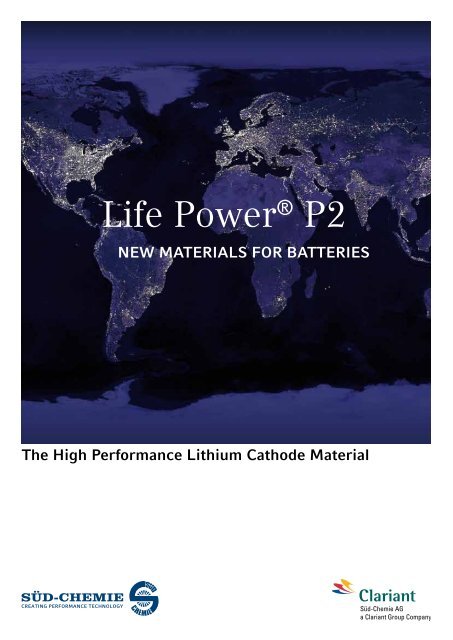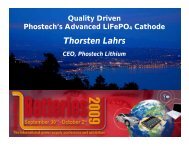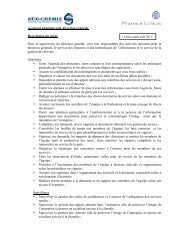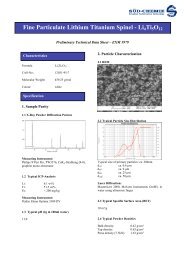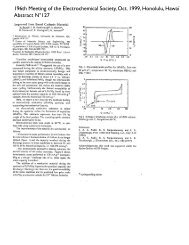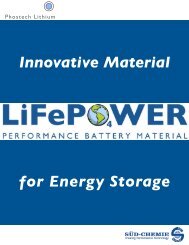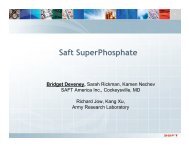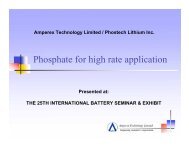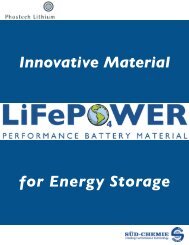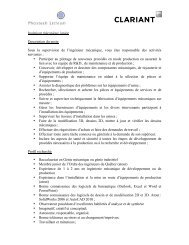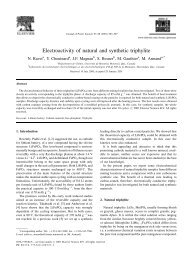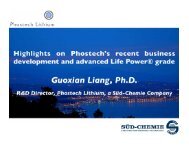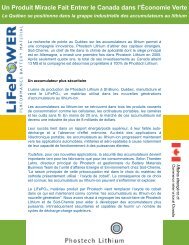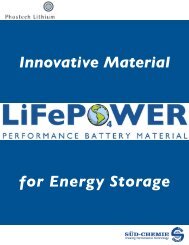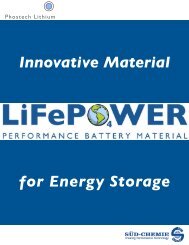Life Power® P2 - Phostech Lithium inc.
Life Power® P2 - Phostech Lithium inc.
Life Power® P2 - Phostech Lithium inc.
You also want an ePaper? Increase the reach of your titles
YUMPU automatically turns print PDFs into web optimized ePapers that Google loves.
<strong>Life</strong> Power ® <strong>P2</strong><br />
New MAterIALS for BAtterIeS<br />
the High Performance <strong>Lithium</strong> Cathode Material
2<br />
Introduction<br />
Clean mobility and clean energy are two major<br />
challenges that the world is facing today. The automotive<br />
industry is actively working on the mobility<br />
challenge with the development of new hybrid<br />
and electric vehicles. At the same time, conscious<br />
efforts to use more renewable sources for energy<br />
generation have boosted the need for energy<br />
storage that can manage the variable power output<br />
of solar and wind systems.<br />
The fundamental building block for both of these<br />
applications is the rechargeable battery.<br />
Süd-Chemie produces two of the primary materials<br />
used for batteries – the cathode and the anode –<br />
that provide superior electrochemical performance<br />
and enhanced safety and affordability. It is the<br />
combination of these critical properties that best<br />
meets the clean energy and mobility needs of today.<br />
The cathode material from Süd-Chemie is made from<br />
<strong>Lithium</strong> Iron Phosphate, LiFePO 4 , which is the only<br />
inherently safe cathode material discovered to date.<br />
<strong>Life</strong> Power ® <strong>P2</strong><br />
In the 1990’s, Professor John B. Goodenough<br />
discovered that LiFePO 4 , often referred to as LFP,<br />
could be a good cathode material for <strong>Lithium</strong><br />
ion batteries. Later research showed that the<br />
application of a carbon coating provided an<br />
additional boost in performance. In 2001,<br />
Süd-Chemie developed a process that produced<br />
a high performance carbon-coated LFP that<br />
addresses the performance demands of the<br />
energy storage applications.<br />
This new class of battery materials from<br />
Süd-Chemie is known as <strong>Life</strong> Power ® . These high<br />
power cathode materials deliver superior performance,<br />
safety and cycle-life in all energy storage<br />
applications. In particular, LFP is emerging as the<br />
preferred material for batteries for electro-mobility<br />
due to its intrinsic safety, high power, and fastcharging<br />
capability. This unique safety performance<br />
can be translated to lower system cost with less<br />
demand on the energy management systems in the<br />
final product.<br />
For stationary applications, batteries based on LFP<br />
can provide the storage needed to manage the<br />
variable power generation of renewable sources<br />
such as such as wind and solar. In some regions of<br />
the world, renewable energies now provide more<br />
than 10% of the energy production, and many<br />
countries have long term plans to produce 50% or<br />
more of their energy through green technologies.<br />
Batteries are the key to balancing the generation<br />
fluctuations, either with large centralized units or<br />
smaller decentralized solutions.<br />
Several companies are now working on home-based<br />
energy storage systems (ESS) with <strong>Lithium</strong> ion batteries.<br />
And, as with automotive applications, safety<br />
and long-life are key demands from the market.<br />
Süd-Chemie <strong>Life</strong> Power ® <strong>P2</strong> provides an answer to<br />
both demands. It offers the inherently safe cathode<br />
material LFP in combination with <strong>Lithium</strong> Titanate,<br />
Li 4 Ti 5 O 12 . In tests this combination has proven<br />
>20.000 cycles, thus indicating that those systems<br />
may last for 20 years.
Applications<br />
<strong>Life</strong> Power ® <strong>P2</strong> can be used in a variety of Automotive and Stationary applications, as illustrated below,<br />
and for Consumer products.<br />
Automotive:<br />
• Hybrid Electric Vehicle<br />
(HEV/PHEV)<br />
• Electric Vehicle (EV)<br />
• Starter Battery 12V<br />
to grid<br />
Stationary Applications:<br />
• Storage of Renewable Energy in Home Energy Storage Systems<br />
• Peak Demands in Electric Grid<br />
• Regulation of Electric Voltage<br />
• Frequency Regulation<br />
4<br />
5<br />
2 3<br />
1<br />
1 PV-Modules<br />
2 Energy Management<br />
3 Li-Ion-Battery<br />
4 Grid-Connection<br />
5 Distribution<br />
<strong>Life</strong> Power ® <strong>P2</strong> 3
4<br />
Product Performance<br />
the Advantages of <strong>Life</strong> Power ® <strong>P2</strong><br />
• Inherent safety<br />
• Long cycle-life<br />
• Long calendar life<br />
• Very high discharge power<br />
• Fast-charge option<br />
• Outstanding performance<br />
at low temperature<br />
why is <strong>Life</strong>Po 4 INHereNtLY SAfe?<br />
Unlike other cathode materials, <strong>Lithium</strong> Iron<br />
Phosphate exists in nature in both discharged and<br />
charged forms; consequently both minerals are<br />
stable. The oxygen in the phosphate is fixed to<br />
the phosphorus by strong covalent bonds. Other<br />
figure 1: <strong>Life</strong>Po (discharged condition)<br />
4<br />
called triphylite<br />
<strong>Life</strong> Power ® <strong>P2</strong><br />
• Cyclability<br />
• Deep discharge capability<br />
• Environmentally friendly<br />
• Significant cost advantage<br />
• Lower total system cost<br />
• Availability<br />
cathode materials, especially nickelate, tend to<br />
release oxygen when heated > 230°C, which could<br />
potentially lead to temperature run-away reactions.<br />
This temperature excursion is not a concern for<br />
batteries based on LFP.<br />
figure 2: fePo (charged condition)<br />
4<br />
called Heterosite
figure 3: SeM photograph of <strong>Life</strong> Power ® <strong>P2</strong><br />
Süd-Chemie <strong>Life</strong> Power ® <strong>P2</strong> is manufactured using<br />
a proprietary wet process that produces LiFePO 4<br />
with outstanding performance. The key contributor<br />
to its superior electrochemical characteristics is<br />
the presence of primary particles in a size between<br />
100-300nm, that are formed in the precipitation<br />
process. An image of the material is shown in the<br />
Scanning Electron Micrograph in Figure 3 above.<br />
Reversible Capacity (%)<br />
100<br />
90<br />
80<br />
70<br />
60<br />
50<br />
40<br />
30<br />
20<br />
10<br />
0<br />
0 2000 4000 6000 8000<br />
cycles<br />
10000<br />
Cycle <strong>Life</strong> Characteristics [1C/1C, RT, CC-CV charge]<br />
figure 5: Cycle <strong>Life</strong> of LfP in combination with Lto<br />
at room temperature (courtesy of Leclanche SA)<br />
Potential (V)<br />
spec. capacity (mAh/g)<br />
4<br />
3.5<br />
3<br />
2.5<br />
2<br />
180<br />
160<br />
140<br />
120<br />
100<br />
80<br />
60<br />
40<br />
20<br />
0<br />
– Cycle 1 – Cycle 3<br />
0 50 100 150<br />
Spec. capacity (mAh/g)<br />
figure 4: Specific Capacity of <strong>Life</strong> Power ® <strong>P2</strong><br />
<strong>Life</strong> Power ® <strong>P2</strong> demonstrates a specific capacity of<br />
almost 160mAh/g which is close to the theoretical<br />
maximum value of LiFePO 4 (Figure 4).<br />
In half cell measurements at a 10ºC rate,<br />
<strong>Life</strong> Power ® <strong>P2</strong> demonstrates a specific capacity<br />
> 120mAh/g. This graph shows the potential of<br />
LiFePO 4 for high power applications (Figure 6).<br />
0,0 0,1 1,0 10,0<br />
Rate (C)<br />
figure 6: Specific Capacity of <strong>Life</strong> Power ® <strong>P2</strong><br />
at different discharge currents (C-rate) at 25°C<br />
200<br />
100,0<br />
<strong>Life</strong> Power ® <strong>P2</strong> 5
6<br />
Production<br />
New <strong>Life</strong> Power ® <strong>P2</strong> Production Plant<br />
in Candiac, Canada<br />
Half Cell testing<br />
Quality Inspection<br />
<strong>Life</strong> Power ® <strong>P2</strong><br />
Production<br />
<strong>Life</strong> Power ® <strong>P2</strong> was developed in our R&D facilities<br />
in Moosburg, Germany, where Süd-Chemie operates<br />
a pilot production unit. The pilot facility has<br />
demonstrated consistent high quality production<br />
for several years and battery manufacturers from<br />
all over world have audited its operations.<br />
Based on this success, Süd-Chemie built the first<br />
industrial-size production plant for <strong>Life</strong> Power ® <strong>P2</strong>.<br />
The new plant in Candiac, Canada has a capacity<br />
of 2.400 mt/year and is operated by <strong>Phostech</strong> <strong>Lithium</strong>,<br />
a wholly-owned subsidiary of Süd-Chemie.<br />
The plant began operating in December 2011.<br />
Quality<br />
A Central Quality Organization at Süd-Chemie<br />
ensures that customers and stakeholders quality,<br />
environmental, health and safety requirements<br />
are met. Based on global EHSQ standards and a<br />
proven EHSQ network, Süd-Chemie manages the<br />
risks and EHSQ performance. Furthermore,<br />
Süd-Chemie is ISO 9001 and ISO 14001 certified.<br />
The co-located analysis laboratory supports the<br />
daily production and ensures the quality and<br />
performance of <strong>Life</strong> Power ® <strong>P2</strong>. Based on its pilot<br />
plant operations in Moosburg for the past several<br />
years, Süd-Chemie has gained a thorough understanding<br />
of the important parameters.<br />
Süd-Chemie has protected its technology by patent<br />
applications and granted patents.
Handling<br />
Handling<br />
<strong>Life</strong> Power ® <strong>P2</strong> is produced and packaged under<br />
very dry conditions. The presence of moisture<br />
could lead to adverse effects in battery performance,<br />
therefore, <strong>Life</strong> Power ® <strong>P2</strong> is shipped in<br />
aluminum-metalized sealable bags with a plastic<br />
inner-liner for optimal moisture-barrier protection.<br />
Süd-Chemie recommends that the bags be opened<br />
in a dry room atmosphere (-40°C dew point). If a<br />
dry room is not available, the produced LiFePO 4<br />
cathode should be dried in a vacuum dryer with<br />
max. temperature of 120°C.<br />
<strong>Life</strong> Power ® <strong>P2</strong> cathode slurry can be produced<br />
with conventional solvents, such as N-Methylpyrrolidone<br />
(NMP), or with water-based binders.<br />
It is important to achieve good mixing of the<br />
components; we recommend the use of a high<br />
energy stirrer and/or a homogenizer.<br />
Packaging<br />
<strong>Life</strong> Power ® <strong>P2</strong> is typically delivered in 20kg bags<br />
with plastic inner-liner in a cardboard box.<br />
20 boxes can be loaded on a pallet to a total<br />
weight of 400kg; 20” and 40’ containers have a<br />
total weight of 8.000kg and 16.000kg, respectively.<br />
Storage<br />
<strong>Life</strong> Power ® <strong>P2</strong> can be stored in closed bags<br />
for more than 6 months without effect on the<br />
electrochemical performance. It is important to<br />
store opened bags of <strong>Life</strong> Power ® <strong>P2</strong> under dry<br />
conditions as it tends to pick up moisture even<br />
in a very short exposure time.<br />
<strong>Life</strong> Power ® is a registered trademark of Süd-Chemie.<br />
Süd-Chemie is a member of the Clariant Group, Muttenz, Switzerland.<br />
<strong>Life</strong> Power ® <strong>P2</strong> 7
Contact Information<br />
The information contained in this leaflet is based on our research and experience. Information is given in good faith, but under no circumstances does it constitute any guarantee, representation,<br />
or warranty for such features. Any responsibility and/or liability of Süd-Chemie-Group Companies is limited to written contractual terms and conditions as agreed by Süd-Chemie-Group Companies<br />
and the respective customers for specific product data and/or features. January 2012<br />
Europe and Middle East<br />
Süd-Chemie AG<br />
Waldheimer Str. 15<br />
83052 Bruckmühl<br />
Germany<br />
Phone: +49 8061 4903-516<br />
Email: norbert.modl@sud-chemie.com<br />
Americas<br />
<strong>Phostech</strong> <strong>Lithium</strong>, Inc.<br />
280 Ave Liberte · Candiac,<br />
Quebec, Canada J5R 6X1<br />
Phone: +1 514-906-1359<br />
Email: michel.parent@sud-chemie.com<br />
www.sud-chemie.com<br />
Asia-Pacific<br />
Süd-Chemie Japan<br />
5F, Shinjuku Maynds Tower, 1-1,<br />
Yoyogi 2-chome, Shibayu,<br />
Tokyo, Japan 151-0053<br />
Phone: +81 3 5308-9333<br />
Email: tsuneyoshi.takase@sud-chemie.com<br />
Süd-Chemie Investment Management Shanghai<br />
Westgate Tower<br />
1038 West Nanjing Road<br />
Shanghai 200041 China<br />
Phone: +86 21 62184480<br />
Email: tony.chen@sud-chemie.com<br />
Süd-Chemie Korea<br />
527,Okmyeong-Ri,Daesong-Myeon<br />
Pohang, Gyeongbuk<br />
790-841 Korea<br />
Phone: +82 54 278 2141<br />
Email: min-sub.song@sud-chemie.com


